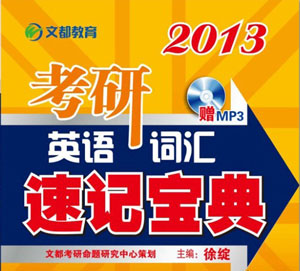|
||||
|
Part I Writing (30 minutes) Directions:For this part, you are allowed 30 minutes to write a short essay entitled Say No to Pirated Products.You should write at least 150 words following the outline given below: 1. 目前盗版的现象比较严重 2. 造成这种现象的原因及其危害 3. 我们应该怎么做 ____________________________________________________________ ____________________________________________________________ ____________________________________________________________ ____________________________________________________________ Useful words and expressions: 盗版:piracy(n.) 盗版产品:pirated products 知识产权: intellectual property rights 侵犯版权:infringe sb's copyright;copyright infringement Say No to Pirated Products [NextPage] Part Ⅱ Reading Comprehension (Skimming and Scanning)(15 minutes) For questions 14, mark Y (for YES) if the statement agrees with the information given in the passage; N (for NO) if the statement contradicts the information given in the passage; NG (for NOT GIVEN) if the information is not given in the passage. For questions 510, complete the sentences with the information given in the passage.
Rainforests Tropical rainforests are the most diverse ecosystem(生态系统)on Earth, and also the oldest. Today, tropical rainforests cover only 6 percent of the Earth's ground surface, but they are home to over half of the planet's plant and animal species. Generally speaking, a rainforest is an environment that receives high rainfall and is dominated by tall trees. A wide range of ecosystems fall into this category, of course. But most of the time when people talk about rainforests, they mean the tropical rainforests located near the equator. These forests receive between 160 and 400 inches of rain per year. The total annual rainfall is spread pretty evenly throughout the year, and the temperature rarely dips below 60 degrees Fahrenheit. This steady climate is due to the position of rainforests on the globe. Because of the orientation of the Earth's axis, the Northern and Southern hemispheres each spend part of the year tilted away from the sun. Since rainforests are at the middle of the globe, located near the equator, they are not especially affected by this change. They receive nearly the same amount of sunlight, and therefore heat, all year. Consequently, the weather in these regions remains fairly constant. As you go lower, down into the rainforest, you find less and less greenery. The forest floor is made up of moss, fungi, and decaying plant matter that has fallen from the upper layers. The reason for this decrease in greenery is very simple:The overabundance of plants gathering sunlight at the top of the forest blocks most sunlight from reaching the bottom of the forest, making it difficult for robust plants to thrive. The Forest for the Trees The ample sunlight and extremely wet climate of many tropical areas encourage the growth of towering trees with wide canopies. This thick top layer of the rainforest dictates the lives of all other plants in the forest. New tree seedlings rarely survive to make it to the top unless some older trees die, creating a "hole" in the canopy. When this happens, all of the seedlings on the ground level compete intensely to reach the sunlight. Many plant species reach the top of the forest by climbing the tall trees. It is much easier to ascend this way, because the plant doesn't have to form its own supporting structure. Some plant species, called epiphytes, grow directly on the surface of the giant trees. These plants, which include a variety of orchids and ferns, make up much of the under story, the layer of the rainforest right below the canopy. Epiphytes are close enough to the top to receive adequate light, and the runoff from the canopy layer provides all the water and nutrients(养分)they need, which is important since they don't have access to the nutrients in the ground. Stranglers and Buttresses Competition over nutrients is almost as intense as competition for light. The excessive rainfall rapidly dissolves nutrients in the soil, making it relatively infertile except at the top layers. For this reason, rainforest tree roots grow outward to cover a wider area, rather than downward to lower levels. This makes rainforest trees somewhat unstable, since they don't have very strong anchors in the ground. Some trees compensate for this by growing natural buttresses. These buttresses are basically tree trunks that extend out from the side of the tree and down to the ground, giving the tree additional support. Rainforest trees are dependent on bacteria that are continually producing nutrients in the ground. Rainforest bacteria and trees have a very close, symbiotic(共生的) relationship. The trees provide the bacteria with food, in the form of fallen leaves and other material, and the bacteria break this material down into the nutrients that the trees need to survive. One of the most remarkable things about rainforest plant life is its diversity. The temperate rainforests of the Pacific Northwest are mainly composed of a dozen or so tree species. A tropical rainforest, on the other hand, might have 300 distinct tree species. All Creatures, Great and Small Rainforests are home to the majority of animal species in the world. And a great number of species who now live in other environments, including humans, originally inhabited the rainforests. Researchers estimate that in a large rainforest area, there may be more than 10 million different animal species. Most of these species have adapted for life in the upper levels of the rainforest, where food is most plentiful. Insects, which can easily climb or fly from tree to tree, make up the largest group(ants are the most abundant animal in the rainforest).Insect species have a highly symbiotic relationship with the plant life in a rainforest. The insects move from plant to plant, enjoying the wealth of food provided there. As they travel, the insects may pick up the plants' seeds, dropping them some distance away. This helps to disperse the population of the plant species over a larger area. The numerous birds of the rainforest also play a major part in seed dispersal. When they eat fruit from a plant, the seeds pass through their digestive system. By the time they excrete (排泄) the seeds, the birds may have flown many miles away from the fruit-bearing tree. There are also a large number of reptiles and mammals in the rainforest. Since the weather is so hot and humid during the day, most rainforest mammals are active only at night, dusk or dawn. The many rainforest bat species are especially well adapted for this lifestyle. Using their sonar, bats navigate easily through the mass of trees in the rainforest, feeding on insects and fruit. While most rainforest species spend their lives in the trees, there is also a lot of life on the forest floor. Great apes, wild pigs, big cats and even elephants can all be found in rainforests. There are a number of people who live in the rainforests, as well. These tribes - which, up until recently, numbered in the thousands - are being forced out of the rainforests at an alarming rate because of deforestation. Deforestation In the past hundred years, humans have begun destroying rainforests at an alarming rate. Today, roughly 1.5 acres of rainforest are destroyed every second. People are cutting down the rainforests in pursuit of three major resources:
In the current economy, people obviously have a need for all of these resources. But almost all experts agree that, over time, we will suffer much more from the destruction of the rainforests than we will benefit. The world's rainforests are an extremely valuable natural resource, to be sure, but not for their lumber or their land. They are the main cradle of life on Earth, and they hold millions of unique life forms that we have yet to discover. Destroying the rainforests is comparable to destroying an unknown planet-we have no idea what we're losing. If deforestation continues at its current rate, the world's tropical rainforests will be wiped out within 40 years. 1. Virtually all plant and animal species on Earth can be found in tropical rainforests. 2. There is not much change in the weather in the tropical rainforests all the year round. 3. The largest number of rainforests in the world are located on the African continent. 4. Below the canopy level of a tropical rainforest grows an overabundance of plants. 5. New tree seedlings will not survive to reach the canopy level unless ________. 6. Epiphytes, which form much of the under story of the rainforest, get all their water and nutrients from ________. 7. Stranglers are so called because they ________ by blocking the sunlight and competing for the nutrients. 8. Since rainforest bacteria and trees depend on each other for life, the relationship they form is termed ________. 9. Plant species are dispersed over a large area with the help of ________. 10. As we are still ignorant of millions of unique life forms in the rainforest, deforestation can be compared to the destruction of ________. Part III Listening Comprehension (35 minutes) Section A 11. A) She isn't going to change her major. B) She plans to major in tax law. C) She studies in the same school as her brother. D) She isn't going to work in her brother's firm. 12. A) She will do her best if the job is worth doing. B) She prefers a life of continued exploration. C) She will stick to the job if the pay is good. D) She doesn't think much of job-hopping. 13. A) Stop thinking about the matter. B) Talk the drug user out of the habit. C) Be more friendly to his schoolmate. D) Keep his distance from drug addicts. 14. A) The son. B) The father. C) The mother. D) Aunt Louise. 15. A) Stay away for a couple of weeks. B) Check the locks every two weeks. C) Look after the Johnsons' house. D) Move to another place. B) He didn't want to be held up in traffic. C He wanted to make sure they got tickets. D) He wanted to catch as many game birds as possible. B) It will stimulate business activities. C) It will mainly benefit the wealthy. D) It will cut the stockholders' dividends. B) The man can ask the department store for help. C) She doesn't have the hotel's phone number. D) The hotel is just around the corner. Questions 19 to 21 are based on the conversation you have just heard. 19. A) To interview a few job applicants. B) To fill a vacancy in the company. C) To advertise for a junior sales manager. D) To apply for a job in a major newspaper. B) A young man good at managing his time. C) A college graduate with practical working experience. D) A young man with his own idea of what is important. B) Not likely to be met. C) Reasonable enough. D) Apparently ***ist. Questions 22 to 25 are based on the conversation you have just heard. 22. A) The latest developments of an armed rebellion in Karnak. B) The fall of Karnak's capital city into the hands of the rebel forces. C) The epidemic that has just broken out in the country of Karnak. D) The peace talks between the rebels and the government in Karmak. 23. A) The epidemic has been brought under control. B) There are signs of progress in the peace process. C) Great improvements are being made in its capital. D) There's little hope of bringing the conflict to an end. 24. A) Late in the morning. B) Early in the afternoon. C) Sometime before dawn. D) Shortly after sunrise. 25. A) Inadequate medical care. B) Continuing social unrest. C) Lack of food, water and shelter. D) Rapid spreading of the epidemic. Section B Passage One Questions 26 to 28 are based on the passage you have just heard. 26. A) One of the bridges between North and South London collapsed. B) The heart of London was flooded. C) An emergency exercise was conducted. D) A hundred people in the suburbs were drowned. 27. A) Fifty underground stations were made waterproof. B) A flood wall was built. C) An alarm system was set up. D) Rescue teams were formed 28. A) Most Londoners were frightened. B) Most Londoners became rather confused. C) Most Londoners took Exercise Floodwall calmly. D) Most Londoners complained about the trouble caused by Exercise Floodwall. Passage Two Questions 29 to 31 are based on the passage you have just heard. 29. A) It limited their supply of food. C) It destroyed many of their nests. B) It made their eggshells to fragile. D) It killed man baby bald eagles. 30. A) They found ways to speed up the reproduction of bald eagles. B) They developed new types of feed for baby bald eagles. C) They explored new ways to hatch baby bald eagles. D) They brought in bald eagles from Canada. 31. A) Pollution of the environment. B) A new generation of pest killers. C) Over-killing by hunters. D) Destruction of their natural homes. Passage Three Questions 32 to 35 are based on the passage you have just heard. 32. A) Why people hold back their tears. C) How to restrain one's tears. B) Why People cry. D) How tears are produced. 33. A) What chemicals tears are composed of. B) Whether crying really helps us feel better. C) Why some people tend to cry more often than others. D) How tears help people cope with emotional problems. 34. A) Only one out of four girls cries less often than boys. B) Of four boys, only one cries very often. C) Girls cry four times as often as boys. D) Only one out of four babies doesn't cry often. 35. A) Only humans respond to emotions by shedding tears. B) Only humans shed tears to get rid of imitating stuff in their eyes. C) Only human tears can resist invading bacteria. D) Only human tears can discharge certain chemicals. Section C He was a funny-looking man with a cheerful face, good-natured and a great talker. He was (36) ________ by his student, the great pltilosopher Plato, as "the best and most just and wisest man." Yet this same man was (37) ________ to death for his beliefs by a jury composed of the leading figures of the time in Athens. The man was the Greek philosopher Socrates, and he was put to death for not believing in the recognized gods and for (38) ________ young people. The second charge steamed from his (39) ______ with numerous young men who came to Athens from all over the (40) ______ world to study under him. Socrates method of leaching was to ask questions and by (41) ________ not to know the answers, to (42) ________ his students into thinking for themselves. His teachings had (43) ______ influence on all the great Greek and Roman schools of philosophy. Yet for all his fame and influence. Socrates himself never wrote a word. Socrates (44) _____________________________________________________________ in Athens. They wanted him silenced. Yet many were probably surprised that he accepted death so readily. Socrates (45) _____________________________________________________________. But socrates, as a firm believer in law, reasoned that it was proper to submit to the death sentence (46) ____________________________________________. Part Ⅳ Reading Comprehension (Reading in Depth) (25 minutes) Section A Questions 47 to 51 are based on the following passage. America is a country that now sits atop the cherished myth that work provides rewards, that working people can support their families. It's a myth that has become so divorced from reality that it might as well begin with the words "Once upon a time." Today 1.6 million New Yorkers suffer from "food insecurity," which is a fancy way of saying they don't have enough to eat. Some are the people who come in at night and clean the skyscrapers that glitter along the river. Some pour coffee and take care of the aged parents of the people who live in those buildings. The American Dream for the well-to-do grows from the bowed backs of the working poor, who too often have to choose between groceries and rent. In a new book called "The Betrayal of Work", Beth Shulman says that even in the booming 1990s one out of every four American workers made less than $8.70 an hour, an income equal to the government's poverty level for a family of four. Many, if not most, of these workers had no health care, sick pay or retirement provisions. We ease our consciences, Shulman writes, by describing these people as "low skilled," as though they're not important or intelligent enough to deserve more. But low-skilled workers today are better educated than ever before, and they constitute the linchpin (关键) of American industry. When politicians crow (得意洋洋地说) that happy days are here again because jobs are on the rise, it's these jobs they're really talking about. Five of the 10 occupations expected to grow big in the next decade are in the lowest-paying job groups. And before we sit back and decide that's just the way it is, it's instructive to consider the rest of the world. While the bottom 10 percent of American workers earn just 37 percent of our average wage, their counterparts in other industrialized countries earn upwards of 60 percent. And those are countries that provide health care and child care, which eases the economic pinch considerably. Almost 40 years ago, when Lyndon Johnson declared war on poverty, a family with a car and a house in the suburbs felt prosperous. Today that same family may well feel poor, overwhelmed by credit card debt, a second mortgage and the cost of the stuff that has become the backbone of American life. When the middle class feels poor, the poor have little chance for change, or even recognition. 47. By saying "it might as well begin with the words ‘Once upon a time'" (Line 3, Para.1), the author suggests that the American myth is ________. 48. What is the American Dream of the well-to-do built upon? 49. Some Americans try to make themselves feel less guilty by attributing the poverty of the working people to ________. 50. We learn from the passage that the difference in pay between the lowest paid and the average worker in America is ________ than that in other industrialized countries. 51. According to the author, how would an American family with a car and a house in the suburbs probably feel about themselves today?
Section B Passage One Questions 52 to 56 are based on the following passage. As a wise man once said, we are all ultimately alone. But an increasing number of Europeans are choosing to be so at an ever earlier age. This isn't the stuff of gloomy philosophical contemplations, but a fact of Europe's new economic landscape, embraced by sociologists, real-estate developers and ad executives alike. The shift away from family life to solo lifestyle, observes a French sociologist, is part of the "irresistible momentum of individualism" over the last century. The communications revolution, the shift from a business culture of stability to one of mobility and the mass entry of women into the workforce have greatly wreaked havoc on (扰乱) Europeans' private lives. Europe's new economic climate has largely fostered the trend toward independence. The current generation of home-aloners came of age during Europe's shift from social democracy to the sharper, more individualistic climate of American-style capitalism. Raised in an era of privatization and increased consumer choice, today's tech-savvy (精通技术的) workers have embraced a free market in love as well as economics. Modern Europeans are rich enough to afford to live alone, and temperamentally independent enough to want to do so. Once upon a time, people who lived alone tended to be those on either side of marriage-twenty something professionals or widowed senior citizens. While pensioners, particularly elderly women, make up a large proportion of those living alone, the newest crop of singles are high earners in their 30s and 40s who increasingly view living alone as a lifestyle choice. Living alone was conceived to be negative-dark and cold, while being together suggested warmth and light. But then came along the idea of singles. They were young, beautiful, strong! Now, young people want to live alone. The booming economy means people are working harder than ever. And that doesn't leave much room for relationships. Pimpi Arroyo, a 35-year-old composer who lives alone in a house in Paris, says he hasn't got time to get lonely because he has too much work. "I have deadlines which would make life with someone else fairly difficult." Only an Ideal Woman would make him change his lifestyle, he says. Kaufmann, author of a recent book called "The Single Woman and Prince Charming," thinks this fierce new individualism means that people expect more and more of mates, so relationships don't last long-if they start at all. Eppendorf, a blond Berliner with a deep tan, teaches grade school in the mornings. In the afternoon she sunbathes or sleeps, resting up for going dancing. Just shy of 50, she says she'd never have wanted to do what her mother did-give up a career to raise a family. Instead. "I've always done what I wanted to do:live a self-determined life." 52. More and more young Europeans remain single because ________. A) they are driven by an overwhelming sense of individualism B) they have entered the workforce at a much earlier age C) they have embraced a business culture of stability D) they are pessimistic about their economic future 53. What is said about European society in the passage? A) It has fostered the trend towards small families. B) It is getting closer to American style capitalism. C) It has limited consumer choice despite a free market. D) It is being threatened by irresistible privatization. 54. According to Paragraph 3, the newest group of singles are ________. A) warm and light hearted C) negative and gloomy B) on either side of marriage D) healthy and wealthy 55. The author quotes Eppendorf to show that ________. A) some modern women prefer a life of individual freedom B) the family is no longer the basic unit of society in present-day Europe C) some professional people have too much work to do to feel lonely D) most Europeans conceive living a single life as unacceptable 56. What is the author's purpose in writing the passage? A) To review the impact of women becoming high earners. B) To contemplate the philosophy underlying individualism. C) To examine the trend of young people living alone. D) To stress the rebuilding of personal relationships. Passage Two Questions 57 to 61 are based on the following passage. Supporters of the biotech industry have accused an American scientist of misconduct after she testified to the New Zealand government that a genetically modified (GM) bacterium could cause serious damage if released. The New Zealand Life Sciences Network, an association of pro-GM scientists and organizations, says the view expressed by Elaine Ingham, a soil biologist at Oregon State University in Corvallis, was exaggerated and irresponsible. It has asked her university to discipline her. But Ingham stands by her comments and says the complaints are an attempt to silence her. "They're trying to cause trouble with my university and get me fired," Ingham told New Scientist. The controversy began on 1 February, when Ingham testified before New Zealand's Royal Commission on Genetic Modification, which will determine how to regulate GM organisms. Ingham claimed that a GM version of a common soil bacterium could spread and destroy plants if released into the wild. Other researchers had previously modified the bacterium to produce alcohol from organic waste. But Ingham says that when she put it in soil with wheat plants, all of the plants died within a week. "We would lose terrestrial (陆生的) plants...this is an organism that is potentially deadly to the continued survival of human beings," she told the commission. She added that the U.S. Environmental Protection Agency (EPA) canceled its approval for field tests using the organism once she had told them about her research in 1999. But last week the New Zealand Life Sciences Network accused Ingham of "presenting inaccurate, careless and exaggerated information" and "generating speculative doomsday scenarios (世界末日的局面) that are not scientifically supportable". They say that her study doesn't even show that the bacteria would survive in the wild, much less kill massive numbers of plants. What's more, the network says that contrary to Ingham's claims, the EPA was never asked to consider the organism for field trials. The EPA has not commented on the dispute. But an e-mail to the network from Janet Anderson, director of the EPA's bio-pesticides (生物杀虫剂) division, says "there is no record of a review and/or clearance to field test" the organism. Ingham says EPA officials had told her that the organism was approved for field tests, but says she has few details. It's also not clear whether the organism, first engineered by a German institute for biotechnology, is still in use. Whether Ingham is right or wrong, her supporters say opponents are trying unfairly to silence her. "I think her concerns should be taken seriously. She shouldn't be harassed in this way," says Ann Clarke, a plant biologist at the University of Guelph in Canada who also testified before the commission. "It's an attempt to silence the opposition." 57. The passage centers on the controversy ________. A) between American and New Zealand biologists over genetic modification B) as to whether the study of genetic modification should be continued C) over the possible adverse effect of a GM bacterium on plants D) about whether Elaine lngham should be fired by her university 58. Ingham insists that her testimony is based on ________. A) evidence provided by the EPA of the United States B) the results of an experiment she conducted herself C) evidence from her collaborative research with German biologists D) the results of extensive field tests in Corvallis, Oregon 59. According to Janet Anderson, the EPA ________. A) has canceled its approval for field tests of the GM organism B) hasn't reviewed the findings of Ingham's research C) has approved field tests using the GM organism D) hasn't given permission to field test the GM organism 60. According to Ann Clarke, the New Zealand Life Sciences Network ________. A) should gather evidence to discredit Ingham's claims B) should require that the research by their biologists be regulated C) shouldn't demand that Ingham be disciplined for voicing her views D) shouldn't appease the opposition in such a quiet way 61. Which of the following statements about Ingham is TRUE? A) Her testimony hasn't been supported by the EPA. B) Her credibility as a scientist hasn't been undermined. C) She is firmly supported by her university. D) She has made great contributions to the study of GM bacteria. Part Ⅴ Error Correction (15 minutes) The Seattle Times Company is one newspaper firm that
Part Ⅵ Translation(5 minutes) 72. It was essential that _____________________________________ (我们在月底前签订合同). 73. To our delight, she ______________________________ (进大学一个月就适应了校园生活). 74. The new government was accused _____________________ (未实现其降低失业率的承诺). 75. The workmen think _______________________________________ (遵守安全规则很重要). 76. The customer complained that no sooner ___________________________ (他刚试着使用这台机器, 它就不运转了). KEY Part ⅡReading Comprehension (Skimming and Scanning) 1. N 2. Y 3. NG 4. N 5. some older trees die 6. the canopy layer 7. kill the host tree 8. symbiotic 9. insects and birds/insects/birds/animals 10. an unknown planet Part III Listening Comprehension Section A Section B 26. C 27. B 28. C 29. B 30. D 31. D 32. B 33. D 34. C 35. A
Section C 36. described 37. condemned 38. computing 39. association 40. civilized 41. pretending 42. press 43. unsurpassed 44. encouraged new ideas and free thinking in the young, and this was frightening to the conservatives 45. had the right to ask for a less severe penalty, and he probably could have persuaded the jury to change the verdict 46. So he calmly accepted his fate and drank a cup of poison in the presence of his grief-stricken friends and students Part ⅣReading Comprehension (Reading in Depth) Section A 47. divorced from reality/unrealistic 48. The backbreaking labor of the working poor. /The bowed backs of the working poor. 49. (their)lack of skill/(their)low skill 50. much greater 51. Poor.
Section B 52. A 53. B 54. D 55. A 56. C 57. C 58. B 59. D 60. C 61. A
Part ⅤError Correction
Pant ⅥTranslation |
| [发布者:qiuyu] | |||
|
 当前位置:
当前位置:










